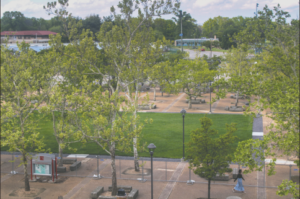
By Rowan Behm
The Scene staff
The Forest Park quad has undergone quite a transformation since workers began demolishing its sunken concrete fountain on March 11.
After seven weeks of breaking up concrete, capping old water pipes and hauling in 1,200 cubic yards of dirt, the former fountain is now a 60-by-80-foot plot of fresh green sod.
The out-of-order fountain hadn’t sprayed water for more than 10 years due to plumbing problems. The new green space is south of Oakland Avenue, east of the theater building, north of the West Wing and west of the library.
“It’s a much better use of space, beautifying the campus,” said Jeff Blankenship, St. Louis Community College’s construction project facilitator.
Originally, officials planned to spend $350,000 on the project’s Phase 1, which included demolition, filling the space with dirt, planting sod and installing accessible concrete paths. But it was completed under budget, according to Blankenship.
“There were no issues whatsoever filling the fountain in,” he said. “It ended up costing $250,000.”
Phase 2 will consist of infrastructural work to keep the space from filling with water. It’s expected to start sometime next year.
Students, faculty and staff have mixed feelings regarding the quad’s transformation. STEM major Ani Sianz Solis Garcia doesn’t like it.
“I feel kind of upset about it just being nothing now,” she said. “It could’ve been something better and not just covered up with grass.”
Diesel mechanic major Daniel Knight, 19, had no strong opinion.
“I didn’t even know the fountain was broken,” he said. “It would’ve been cool if it worked, but either way, what we have now works fine, too. It would probably be more expensive to fix it than to just replace it.”
General studies major Jamal Davis, 41, also seemed ambivalent when asked what he thought of the new grassy area.
“I don’t know,” he said. “I guess it depends on what they’ve got going on and what they’re going to do with it.”
The fountain was part of the original Brutalist-style architecture of the Forest Park campus, which was designed in the 1960s by renowned architects and won multiple awards.
Many people considered the fountain iconic, but college officials said the plumbing problems were too expensive to fix and the concrete steps caused safety concerns.
For now, the transformed area will stay as it is, a grassy lawn surrounded by tables, chairs and trees. Phase 3 plans for furniture and other plants are still in the works.
“Students can play Frisbee, cornhole or just sit and study,” Blankenship said.
